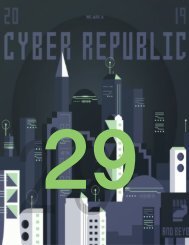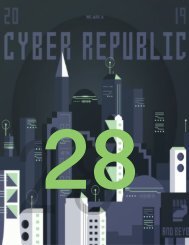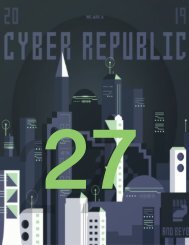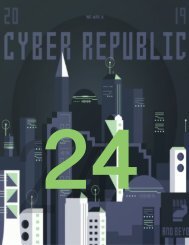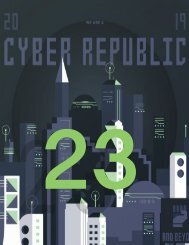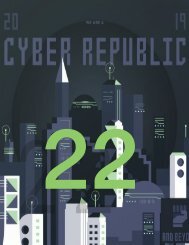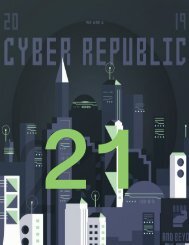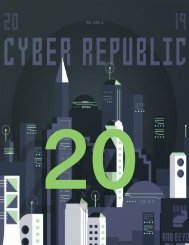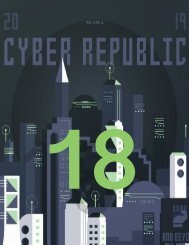Cyber Republic Weekly Update26
Another week and another flurry of news for Cyber Republic. This week, founder Rong Chen participated in a Vancouver meetup with ecosystem partner Wefilmchain, and along with other Elastos representatives, Rong also attended the UNESCO conference in Paris. Ledger has given an update regarding new apps on their hardware. Supernode candidates have posted step by step instructions on voting for Supernodes in the Elastos Wallet and Elephant wallet. Finally, speaking of the Elephant Wallet, there are a handful of new updates.
Another week and another flurry of news for Cyber Republic. This week, founder Rong Chen participated in a Vancouver meetup with ecosystem partner Wefilmchain, and along with other Elastos representatives, Rong also attended the UNESCO conference in Paris. Ledger has given an update regarding new apps on their hardware. Supernode candidates have posted step by step instructions on voting for Supernodes in the Elastos Wallet and Elephant wallet. Finally, speaking of the Elephant Wallet, there are a handful of new updates.
You also want an ePaper? Increase the reach of your titles
YUMPU automatically turns print PDFs into web optimized ePapers that Google loves.
26<br />
//1
CYBER REPUBLIC <strong>Weekly</strong> Update/Issue 26<br />
Rong Speaking at UNESCO<br />
Another week and another flurry of news for <strong>Cyber</strong> <strong>Republic</strong>. This week, founder Rong Chen<br />
participated in a Vancouver meetup with ecosystem partner Wefilmchain,and along with other<br />
Elastos representatives,Rong also attended the UNESCO conference in Paris. Ledger has given<br />
an update regarding new apps on their hardware. Supernode candidates have posted step by<br />
step instructions on voting for Supernodes in the Elastos Wallet and Elephant wallet. Finally,<br />
speaking of the Elephant Wallet, there are a handful of new updates.<br />
On May 11th, at Trinity Western University in Vancouver, Canada, Rong gave a keynote speech<br />
at the Blockchain event set up by ecosystem partner Wefilmchain and the 9cat technical<br />
community. Rong spoken on Elastos, CR, and the evolution of blockchain in general.<br />
Wefilmchain head, Garnet Campbell, introduced the Wefilmchain project. The audience<br />
showed clear engagement throughout the event and ended with an informative Q&A session<br />
that lasted nearly an hour. Vando Media conducted an exclusive interview and reported on the<br />
event as well. After the event, Rong Chen attended a technical meetup organized by 9cat.This<br />
post-event had over 30 people in attendance. Garnet and Rong shared a conversation from the<br />
event that’s been posted on Youtube: https://youtu.be/0Mpp2WD5V7k. They discuss the future<br />
of Wefilmchain along with Elastos partnerships and the Smart Web.<br />
Next, the UNESCO conference in Paris, France. From their website, “UNESCO is the United<br />
Nations Educational, Scientific and Cultural Organization. It seeks to build peace through<br />
international cooperation in Education, the Sciences and Culture. UNESCO's programmes<br />
contribute to the achievement of the Sustainable Development Goals defined in Agenda 2030,<br />
adopted by the UN General Assembly in 2015.” Rong Chen made a keynote speech at the event<br />
that was very well received, and a video is soon to come.<br />
The Elastos community has been eagerly waiting for integration on the popular Ledger<br />
hardware wallet, as Coranos has already submitted his code to Ledger for full audit. Ledger’s<br />
//2
team has released a full statement regarding future apps: “New applications are postponed<br />
until the Nano X hardware wallet is shipped. This has taken priority for Ledger until the new<br />
hardware is available and all current projects migrated.” Elastos is currently on the Ledger<br />
internal and external developments Trello page.The Elastos team will continue to seek updates<br />
until ELA is supported. The good news is that the new Ledger Nano X hardware wallets have<br />
officially shipped and the delay should soon be over.<br />
The Elephant Wallet has made a few updates:<br />
1. Added tokens: USDT, FISH, FIlmC.<br />
2. Added e-Signature interface.<br />
3. Added DPoS supernode public key information.<br />
4. Supported logins by DID on https://developer.elastos.org.<br />
5. Fixed a crash issue when voting in some languages or regions.<br />
The Elephant Wallet team is looking for volunteers to help test new features. If interested,<br />
please contact team member Song for more details. (WeChat ID: SongSJun or<br />
https://t.me/songsjun on Telegram)<br />
Two Supernode candidate pools Noderators and Enter Elastos have made solid contributions<br />
to the community. This time they’ve posted clear instructions on how to vote for Supernodes<br />
in the Elastos Wallet and The Elephant Wallet. Read the “How to Vote for Supernodes” article in<br />
this week’s update.<br />
-By Jeremy G.<br />
//3
CYBER REPUBLIC <strong>Weekly</strong> Update/Issue 26<br />
Table of Contents<br />
//4<br />
2 Intro<br />
5 Summary<br />
6 Voting Walkthrough<br />
9 Elastos Hive<br />
13 Korean Marketing<br />
15 CR Terminology: Block Explorer<br />
19 International Community<br />
22 Interview: Rebecca<br />
26 Community Shout Out!<br />
27 Analytics<br />
30 Forum<br />
35 Glossary<br />
37 Credits
Summary<br />
Read last week’s update on our website:<br />
https://news.cyberrepublic.org/may-13th-2019/<br />
Read the last Elastos <strong>Weekly</strong> Update here:<br />
https://news.elastos.org/elastos-weekly-updates-18-may-2019/<br />
We have a <strong>Cyber</strong> <strong>Republic</strong> Documentation site with relevant introductory information about<br />
the <strong>Cyber</strong> <strong>Republic</strong>, including the constitution, voting and proposals, and leadership. Check it<br />
out here:<br />
https://www.cyberrepublic.org/docs/#/overview/intro<br />
Project Updates<br />
<strong>Cyber</strong> <strong>Republic</strong> Website<br />
Main Project Repo: https://github.com/cyber-republic/<strong>Cyber</strong><strong>Republic</strong><br />
Git Activity and Updates<br />
Please refer to the timeline described on this article for more info:<br />
https://blog.cyberrepublic.org/2018/12/27/important-cyber-republic-announcement<br />
If you are a developer interested in working with the CR or Elastos, here’s a form you can fill<br />
out: https://goo.gl/forms/pvzDYMsVEs10s6U72<br />
If you have any content you’d like to submit to our team, please email us at:<br />
press@cyberrepublic.org<br />
//5
CYBER REPUBLIC <strong>Weekly</strong> Update/Issue 26<br />
Voting Walkthrough<br />
By Jeremy G<br />
It has been a few weeks since the DPoS Elections fully commenced. At first, the new “Elastos<br />
Wallet” was the only wallet capable of voting for Supernodes. Now, the ever-popular Elephant<br />
wallet has incorporated voting onto their platform as well. The community is excited about this<br />
development and has gone above and beyond to help others vote.The following is a set of step-bystep<br />
directions on how to vote for your favorite Supernodes in both the Official Elastos Wallet and<br />
the Elephant Wallet.<br />
First, we have the new Elastos Wallet. As described in a previous article about the various Elastos<br />
wallets: https://news.cyberrepublic.org/all-them-wallets-whats-the-difference/, the Elastos Wallet<br />
“is the official wallet that is dedicated to only ELA.”<br />
All official updates will appear in this wallet, first. Pmhee, a dedicated Elastos admin and member<br />
of the Noderators Supernode group, posted step-by-step directions on how to vote on the Elastos<br />
Wallet: https://twitter.com/pmhee555/status/1129196255496818689/photo/1<br />
1. Select “Discover” on the bottom middle tab of the Elastos Wallet screen.<br />
//6
2. Click on the large “Supernode Election” graphic.<br />
3. Select,“I want to vote.”<br />
4. Click on the Supernode you’d like to vote for.<br />
5. Select “Add to candidate list” at the bottom of the page.<br />
6. After selecting the desired Supernodes, click “View candidate list”.<br />
7. Select “Vote” at the bottom right.<br />
8. Enter the number ELA you’re using to vote and press “Confirm”.<br />
9. “Security Check” will pop up and after you input your wallet password, your vote is in!<br />
The second wallet you can now vote with is the Elephant wallet. This wallet stores multiple digital<br />
currencies and has officially implemented voting functions. Enter Elastos, a Supernode candidate,<br />
has posted directions on how to vote on the Elephant Wallet:<br />
https://twitter.com/ELA_Supernode/status/1129294093736206336/photo/1<br />
1. Select the encircled icon with an eye in it at the middle bottom part of Elephant Wallet.<br />
2. Click on the “Vote for ELA Supernodes” graphic.<br />
//7
CYBER REPUBLIC <strong>Weekly</strong> Update/Issue 26<br />
3. Select “Authorize” from the bottom right.<br />
4. Click on the Supernodes you want to vote for.<br />
5. Select “Vote” at the bottom.<br />
6. Select “Confirm” at the top.<br />
7. Enter the Wallet’s pin number to confirm.<br />
8. Select “My votes” on the bottom right to see the Supernodes you’ve voted for.<br />
Special thanks to Supernode candidates Noderators and Enter Elastos for creating these<br />
walkthroughs to help the community vote for their favorite Supernodes.<br />
Happy voting everyone!<br />
//8
Elastos Hive Team Highlight:<br />
Supernode and Interview<br />
By Bo Leng<br />
Translation and Interview by Joel<br />
The Elastos HIVE Supernode is maintained by the Elastos Hive core development<br />
team and they welcome the community’s support.<br />
Hive is the underlying storage architecture of Elastos. Based on IPFS, it provides a<br />
decentralized storage solution but it is more API friendly and has more features<br />
and higher reliability.<br />
With Hive, dapps gain reliable access to file data using the HTTP API and the<br />
corresponding SDK. Each document is distributed to storage nodes in different<br />
regions of the world through the Hive network for higher data availability. At the<br />
same time, HIVE also provides a feature-rich KV (Key Value) access interfaces,<br />
which simplifies the access process of dapp data, speeds up dapp development<br />
speed, and improves preservation of application data.<br />
All are welcome to contribute code and documentation to HIVE. More dapps<br />
integrated in the Elastos ecosystem will create better solutions based on<br />
decentralized data storage.<br />
The core code of Hive is maintained by StorSwift (storswift.com). StorSwift is a<br />
technology-driven distributed storage company with cutting edge technology<br />
advantages in artificial intelligence storage and decentralized storage. Focusing<br />
on the development of distributed storage systems, the company has deep<br />
technical experience in related fields and has experience in large-scale data<br />
storage operation and maintenance.<br />
Based on decentralized storage technology such as IPFS, StorSwift provides<br />
complete distributed storage products and solutions, providing users with lowcost,<br />
high-performance, high-availability, secure, reliable, fast and convenient<br />
access for massive data access, with leading product and technology advantages<br />
and operational experience in the blockchain storage DApp field.<br />
CR Press has conducted an interview to know more about the Hive project, its<br />
goal of being a DPoS supernode, and its incentive scheme:<br />
//9
CYBER REPUBLIC <strong>Weekly</strong> Update/Issue 26<br />
1. Can you tell us about the Hive team members and how the team works?<br />
Hive is currently a team of about ten people. Of the core team, I am responsible for<br />
the management of the entire project and the development of core modules.<br />
Wang Yi, the chief architect of the Hive team, is responsible for the development of<br />
KV messaging modules and the development of node data synchronization. Wan<br />
Lei is responsible for dapp docking, including the Hive API, as well as product<br />
release and related testing.<br />
2. Being as it is the backend for dapp storage, Hive might not be seen by users who<br />
are actually using Hive technology. Can you tell us in what scenario Hive must be<br />
present for dapp implementation?<br />
If you want to achieve true decentralization with more security, you need to use<br />
Hive. For example, for a decentralized chat application, the underlying storage can<br />
dock AWS, or dock their self-built cloud. The performance will be fine, but there is<br />
a flaw if that application is decentralized but the data is saved using the some<br />
centralised way. If you want to ensure the privacy of your data while improving its<br />
physical reliability (with data distribution across regions), you need to use Hive. If<br />
you want to perform data authentication and other operations, Hive is also<br />
necessary. Hive ensures that you really are the owner of your own data.<br />
3.What are the features that Hive has released? What are the features available for<br />
application/testing? What is the roadmap for future development?<br />
Hive is constantly developing. The current version is a developer preview and<br />
offers the following features:<br />
IPFS-based HTTP API:Access to various dapps through a light client.<br />
File view similar to the traditional file system: Users can operate and view specific<br />
files through traditional methods, such as file name, to avoid the complexity<br />
caused by HASH values and to simplify the development process of dapps. At the<br />
same time, you can mount the folder in Hive through FUSE and read/write files in<br />
POSIX mode.<br />
Data cluster synchronization: data uploaded by users can be automatically<br />
synchronized to multiple nodes to achieve better data availability. The user's file<br />
view is also synchronized to multiple nodes. Read/write data can be done by<br />
getting access from any node, which makes the file operations completely<br />
decentralised.<br />
//10
KV-based message API: Provides a message app based on the Key-Value format,<br />
which is optimized for common application scenarios of dapps.<br />
C/C++ SDK: Provides C/C++ SDK to optimize the logic of data storage process,<br />
and speeds up access to dapps.<br />
In the future, Hive's performance will be further enhanced. Data synchronization<br />
algorithms will be improved, and APIs and SDKs will be provided.At the same time,<br />
in order to access more storage nodes, based on the overall architecture of<br />
Elastos, an incentive mechanism will be introduced to the Hive system and the<br />
corresponding consensus algorithm will improve.<br />
4. What is the difference between Hive and other decentralized storage<br />
solutions?<br />
Hive is based on the popular IPFS project and has made many improvements.<br />
From the perspective of storage, most decentralized storage projects in the<br />
market are based on IPFS or mimic IPFS. Thus, functionally, Hive has many<br />
similarities to other storage projects.<br />
But there are also significant differences.<br />
Hive is part of the Elastos ecosystem, so it is for dapps. Providing dapps with an<br />
excellent data storage platform is its most important task. It can be considered as<br />
the hard disk of Elastos’ operating system, but this hard disk spans different cities<br />
across different continents. It is physically separated and is a decentralized data<br />
storage pool, but it provides a similar user experience to traditional hard drives.<br />
Hive puts data security as the most important priority, protecting data from the<br />
perspective of physical security (data redundancy, high availability), logical<br />
security (preventing random modification), and network security (combining<br />
dapps with data encryption) to ensure data security. This realizes the statement<br />
that “I am the owner of my data”.<br />
5. What role does the establishment of the Hive Supernode play in the<br />
development of the Elastos ecosystem? How will rewards be assigned?<br />
The establishment of the Hive Supernode is on the one hand meant to propagate<br />
the technical growth of Elastos. Hive is extremely important in Elastos’<br />
ecosystem as the base storage architecture. More importantly, it attracts people<br />
to actively use Hive storage to improve the dapp ecosystem.<br />
After being elected as a node, the rewards will be used to maintaining the node<br />
and promote development of Hive. We will give back a considerable part of the<br />
//11
CYBER REPUBLIC <strong>Weekly</strong> Update/Issue 26<br />
proceeds to active voters and further encourage everyone to vote through red<br />
envelope airdrops, or what we call “Red Envelope Rain”.<br />
The node reward mechanism is tentatively similar to the formula used in<br />
ELAlliance. The cost, ratio, and other parameters will be slightly different, and<br />
the interests of the voters will be fully considered.<br />
If elected, the allocation algorithm will be optimized according to the actual<br />
voting data. That said, the ratio will be increased for those who vote more and<br />
vote for a longer period to thank supporter. "Red Envelope Rain” is in addition to<br />
the basic reward distributions, aiming to further encourage voters to vote, to<br />
exercise their power, and to actively participate in the activities of Elastos<br />
community.<br />
//12
Korean Marketing<br />
By Jeremy G.<br />
In March of this year, a marketing proposal was officially passed by the Council to<br />
begin engaging the South Korean community.<br />
https://www.cyberrepublic.org/proposals/5c889492c174e60094ce5497<br />
Jake,the official Community Manager for the South Korea marketing initiative,was<br />
gracious enough to answer some questions for CR Press. This grassroots effort in<br />
South Korea is in the early stages, but the basic strategy in this endeavor is to tap<br />
into the country’s social media outlets, translate documents to Korean, and<br />
engage communities through airdrops.<br />
It is well known that the South Korean cryptocurrency community is extremely<br />
passionate and large, leading to the exclusion of South Korean exchanges on<br />
coinmarketcap.com due to the significantly higher prices that South Korean<br />
exchanges traded at.<br />
The most popular messaging app in the country is called Kakao Talk. Millions of<br />
daily users are on this platform every day. Obviously, Kakao Talk has many crypto<br />
communities on its platform, so Jake held a recent event on Kakao talk with<br />
interested Korean community members, “People participated in the KakaoTalk,<br />
identified Elastos reports, white papers, and created the opportunity to have a Q &<br />
A with each other.”<br />
Jake does his best to involve himself with community members and looks to<br />
answer any and all questions for them.The community is growing quickly and Jake<br />
hopes that he can achieve his goal of 1,500 people in the South Korea Elastos<br />
community.<br />
Jake has also collaborated with a famous Korean “KOL” (social media personality)<br />
on the Kakao Talk app. He organized several fun online activities for Elastos which<br />
attracted many people to the channel. He even offered gift cards to those who<br />
participated. Jake plans to work with this famous social media personality in the<br />
future, as they are very good friends.<br />
Another integral aspect of this marketing program is translation.Without someone<br />
translating the current and past Elastos materials, the Korean community would<br />
not be able to effectively learn about the ecosystem. Jake is fully aware of this, and<br />
he’s made some tremendous progress. Jake explains what he’s achieved thus far,<br />
“We are doing white paper and weekly report translation. The white paper has<br />
//13
CYBER REPUBLIC <strong>Weekly</strong> Update/Issue 26<br />
already been translated. We will also be working on app translation.” Regarding the<br />
“app translation”, Jake is referring to translating the Elephant wallet for Korean<br />
users. As of now, some of the Korean is not entirely correct. The Elastos literature<br />
that he is translating is also being republished by a Korean Blockchain media team<br />
Cryptopresso.com. He believes that his outreach will spread awareness to the<br />
Elastos community.<br />
As for his airdrop plans, Jake is looking to organize an event in which Korean<br />
community members can open up their own wallets and receive an airdrop into<br />
their wallets. This airdrop is tentatively planned for next month. He believes that<br />
once Koreans start utilizing the Elephant Wallet, they will eventually start to<br />
migrate into the overall ecosystem.<br />
Of course, when the Elastos community thinks of Korea, Elastos ecosystem<br />
partner ioeX comes to mind. Jake is fully aware of their presence in the region and<br />
will be looking to work with them in the future. “I often meet with the<br />
representative of ioeX Korea to discuss how to promote Elastos and ioeX in<br />
Korea... We plan to host [meetings] in the future.”<br />
As stated, this South Korean initiative is in its infancy. When asked how the South<br />
Korean Community views Elastos, Jake says that Elastos and CR aren’t in the public<br />
eye of South Korea. “I think cryptocurrencies listed on Upbit are the biggest<br />
competitors,” Jake says. “This is because Korean investors mainly use local<br />
exchanges and search for cryptocurrencies listed in Korea.”<br />
This is a very interesting answer because it sheds light on how South Korea and<br />
many countries have crypto communities that are strictly focused on the buying<br />
and selling of cryptocurrency and not necessarily the adoption or technology of<br />
the cryptocurrency.<br />
There is a lot of work to be done, but Jake is motivated to continue furthering the<br />
Elastos brand in the South Korean community.<br />
//14
CR Terminology<br />
By Kenneth K.<br />
As there are many terms to such a large project like Elastos and the <strong>Cyber</strong> <strong>Republic</strong>, we’ve<br />
decided to build a growing glossary of terms that can help the less technically acquainted<br />
understand better what the tech means and the impact it could have.This week we’re focusing on<br />
Block Explorer.<br />
Term: Block Explorer<br />
“...an online block chain browser which displays the contents of individual blocks and<br />
transactions and the transaction histories and balances of addresses.<br />
Each object is displayed in human-readable form, as a web page, and is given a URL. By using<br />
hyperlinks, it allows users to switch from seeing one piece of data to a related one, with a single<br />
click. Clicking on the hash of an object will move to the page that displays its data.This way, for<br />
instance, you can switch from looking at a transaction, to looking at the previous transaction<br />
which gave this transaction its inputs.All block data is visible, in human-readable or machinereadable<br />
forms, and even some information that is not actually part of blocks.“<br />
Source: https://en.bitcoin.it/wiki/BlockExplorer.com<br />
Layman’s definition:<br />
A blockchain relies on the trustworthiness of its public ledger, and a block explorer is the ledger<br />
in a format that is legible to humans, which looks more like a bunch of confusing numbers and<br />
letters than anything. The amount of available information lends to transparency, and certain<br />
blockchains make it harder or easier to find information and pin it to an individual or a wallet.<br />
That being said, when you are told what you are looking at, it really is quite easy.<br />
//15
CYBER REPUBLIC <strong>Weekly</strong> Update/Issue 26<br />
On the left under “height,” you have an increasing number that is sort of like a measurement of<br />
time, but for the Elastos blockchain. However, unlike time, blockchains have some amount of<br />
randomness to how fast blocks are mined, so that’s why there’s a timestamp right beside the<br />
block height. The block production rate will average out to a certain rate, but there are always<br />
variations that can make it unpredictable. Since there are sidechains to Elastos’ architecture,<br />
this block explorer is showing the main chain. Sidechain blocks may be different and their block<br />
times may be much faster (or slower).<br />
The transactions column represents how many transactions have occurred in that block since<br />
the last block finished.<br />
The mined column is simple to show who got the reward for running the block calculations--this<br />
is the merged mining thing we keep talking about. Usually the organization or person getting<br />
the reward will be larger mining pools since they have more power than most and PoW is<br />
dependent on sheer power. DPoS, which is the other part of Elastos Consensus, significantly<br />
helps make things more fair. As you can see, our merged mining with Bitcoin is working very<br />
well, and at the time of writing we have more than 34% of Bitcoin’s hash power.<br />
Size is how large the block was. Don’t worry about that if you’re a casual user.<br />
You can click around on the block height, see what transactions occurred, what addresses sent<br />
the transactions, their amounts, transaction IDs called “transaction hash”, and some more<br />
confusing numbers flying about. If you get to an address, or enter one of your own (a single<br />
private key has several public addresses, and thus, it helps keep the privacy of the owner by<br />
hiding how much ELA a single owner might have in total), it will look like this:<br />
//16
(Sidenote: all these screencaptures were grabbed by randomly clicking about and are not<br />
associated with known wallets.)<br />
It’s somewhat confusing, but you can see funds going in, and funds going out. This ultimately<br />
allows you to verify transactions, but at the same time, it is confusing enough that tracking every<br />
transaction related to a single person is a bit difficult. What is most useful to a user is if they have a<br />
transaction hash after sending or receiving funds, and they run a search for it in order to verify<br />
that transaction. Searching for all the data on a single address becomes less useful, which is<br />
helpful for privacy. That being said, it’s not impossible to track an address, and it’s not meant to be.<br />
And that’s pretty much it. Elastos’ block explorer also includes a rank list, which is also commonly<br />
called the “rich list”. It is a list of addresses with how much ELA is held. Remember that because<br />
one private key is split up into many addresses, this list can be somewhat meaningless (in the<br />
author’s opinion).The largest of the rank list is comprised of Elastos Foundation and <strong>Cyber</strong><br />
<strong>Republic</strong> committed funds.<br />
//17
CYBER REPUBLIC <strong>Weekly</strong> Update/Issue 26<br />
Image from: https://elanews.net/2018/04/11/ela-metrics-how-is-the-circulating-supplycalculated/<br />
Additionally, address number 6 is a burn wallet, which means that the funds are not accessible<br />
by anyone. This was used for any unsold ELA from angels and crowdsale.<br />
Hopefully that clarifies what you are looking at. There is a lot more utility that can come out of<br />
these block explorers, but this general overview should get you started.<br />
//18
International Community<br />
Activities<br />
Chinese Community Activities<br />
By Joel<br />
Rong Chen:Anti-piracy is actually the foundation of the smart economy<br />
https://mp.weixin.qq.com/s/U7sbr9EzqEZhkrdnslZDAA<br />
Rong Chen:The new generation of Internet Era is coming<br />
https://mp.weixin.qq.com/s/wjgocTvwpjdd7ywx0bfwgA<br />
DID sidechain leads to new results, helping the community that writes with speech recognition<br />
https://mp.weixin.qq.com/s/yXZSUKajpPJla-41ukGIZQ<br />
ELAFISH:A practice of token economy in the gaming field<br />
https://mp.weixin.qq.com/s/x4W584WdzOberdorWLmb5w<br />
CR <strong>Weekly</strong> News - Elastos Supernode! CR News Team!<br />
https://v.qq.com/x/page/m08709zjod6.html<br />
Going into CR, the governance for Elastos community<br />
https://www.bitett.com/portal.php?mod=view&aid=3350<br />
Different aspects of Elastos (part 7 and 8)<br />
https://mp.weixin.qq.com/s/AaFt4q4EdvjfKUvzN167dw<br />
https://forum.cyberrepublic.org/t/topic/1106<br />
AnyPeer has released V3.1.0. The major updates include:<br />
A new friend can easily be added into a default group;<br />
A user can receive a random number of ELA from a pool of ELA;<br />
Can display DPoS nodes;<br />
Optimized group chat;<br />
Added functions including regeneration of wallets and setting sounds in “Settings” page.<br />
To try the new release, go to:<br />
Github: https://github.com/anyxxx/AnyPeer/releases/download/AnyPeer.V3.1.0/AnyPeer.V3.1.0.apk<br />
Google Play: AnyPeer<br />
//19
CYBER REPUBLIC <strong>Weekly</strong> Update/Issue 26<br />
Philippines Community<br />
By Krisha<br />
Blockchain Innovation Tour 2019<br />
Elastos Philippines is happy to have sent a delegation to BIT 2019 led by Philippines Community<br />
Organizer Krisha Anne Amada, Partners Manager Alex Timbol, Dev Coaches Nic Aquino and Michael<br />
Lance, and three young devs.<br />
Making our presence felt at these events is strategic for future collaboration. Several of our friends<br />
also attended: major sponsor C.Estates, a NEM based real estate platform, Blockchain Space, an<br />
events facility for blockchain events, TagCash, a multifunctional wallet and token investment<br />
platform, and exchange LAToken.<br />
LAToken was represented by both Philippine and Indonesian representatives, the latter being a<br />
friend of Elastos Indonesian Community Organizer.<br />
The quality of a networking event is in the complementary mix of participants, and we met four<br />
with whom we could pursue future partnerships: AVXchange, a peer to peer paid movie<br />
distribution platform, Ghostchat, a secure, disappearing messages app, Juan Exchange, a planned<br />
crypto exchange, and DeFi (Distributed Finance), a concept to provide platform lending to the<br />
masses.<br />
Juan Exchange, AVXchange, and Ghostchat are pre-ico late alpha--early beta applications built on<br />
blockchains. Because both are nearing their launches and ICOs, they are committed to<br />
blockchains, but will consider porting to compatible Elastos sidechains post ICOs.<br />
Elastos sidechain offers ease of programming with existing blockchain tools, plus the added<br />
security of Elastos network features like merged mining, digital identity, digital asset, and carrier.<br />
//20
21
CYBER REPUBLIC <strong>Weekly</strong> Update/Issue 26<br />
Interview: Rebecca<br />
By YY<br />
1. Could you introduce yourself and your background?<br />
I graduated with a Master’s in Computer Science and joined Kortide in 2003. Kortide was the<br />
previous company founded by Rong Chen when he came back to China from Microsoft. I<br />
worked as a kernel engineer and developed kernel OS. A few years later, I left Kortide due to<br />
personal reason. I worked for Siemens, Flextronics, Reuters, and Libratone those following years<br />
in different areas of expertise including mobile phone design, big data, smart devices, and<br />
security etc. In early 2018, I joined Elastos and am so happy to be part of the Elastos family and to<br />
work with Rong again.<br />
2. You lead the Elastos Operations Team together with Ben Lee. Could you tell us a little more<br />
about your team structure?<br />
Elastos operation team is primarily a cross-functional team and is responsible for the overall<br />
day-to-day operations of the Elastos Foundation. Some of the main functions include project<br />
development (e.g. Elastos blockchain, Trinity, Carrier, Hive and DMA), ecological project<br />
support, public relations, and other support services including personnel and finance<br />
coordination. Elastos Foundation adopts holacracy management model in which autonomous<br />
decision-making and governance of each of the small groups are coordinated.<br />
3. Elastos Operations team is responsible for several important areas.Could you brief us about<br />
your job scope, objectives, and day-to-day operations? What operations are outsourced to<br />
external parties (e.g. program management, legal and accounting) and what is performed by<br />
//22
the internal staff? What are some of your challenges that you encounter and how do you resolve<br />
them?<br />
My job responsibilities are more focused on engineering development and project management<br />
between the Elastos Smartweb infrastructure development teams which are working on Elastos<br />
blockchain, Carrier, Runtime, Storage and DMA. Meanwhile, we are also providing support for<br />
ecological projects, PR, and overseas teams.<br />
Most of the day-to-day operations are managed within the Elastos Foundation, except for legal<br />
consultancy and audit services which are outsourced to external professional third parties.<br />
As Elastos is a global blockchain project, we are vigorously expanding our overseas developer<br />
communities. The main challenges that we encounter so far are language barrier and the cultural<br />
difference between eastern and western communities. To further improve our communication<br />
process, we hire personnel with both eastern and western backgrounds as well as bilingual<br />
capabilities to narrow the communication gap.<br />
4. The <strong>Cyber</strong> <strong>Republic</strong> is a diverse and robust community with skill-focused teams and subgroups.<br />
To ensure the success of CR, skilled talent is highly sought after. Does your team face<br />
difficulties in talent acquisition? What are your short-term and long-term strategies to attract<br />
and retain the right talent?<br />
CR is a generic term for Elastos community. It consists of Elastos token holders and contributors,<br />
including founding members of Elastos Foundation, all token holders, ecosystem partners as well<br />
as individuals and groups of people who are willing to contribute to the Elastos blockchain<br />
technology and community development.<br />
CR is not a corporation in the traditional sense. It has no organizational structure, no central<br />
management, and does not employ full-time employees. However, CR indeed needs to attract as<br />
many skilled professionals as possible to participate in the development of Elastos ecosystem<br />
and communities. CR in return gives rewards to community members who make contributions.<br />
Currently, the main difficulties are that CR is not widely known yet, how to join CR and the way to<br />
become a contributor is not clear to many people.We will help more people become aware of CR,<br />
understand CR,and participate in CR through the promotion of CR website,suggestions page,and<br />
CR forum.<br />
5. How will your roles and responsibilities transition once <strong>Cyber</strong> <strong>Republic</strong> gains full control in<br />
August of this year? Will you become part of the secretariat? What are your subsequent goals<br />
and roadmaps for your team?<br />
It is not clear to me yet at the moment, but in the future I will still be working with the Elastos core<br />
team until we complete the development of the smart web infrastructure. The members of the<br />
new CR Council will form a Secretariat with the appointment of a new Secretary-General.<br />
//23
CYBER REPUBLIC <strong>Weekly</strong> Update/Issue 26<br />
6. How do you feel about the progress and effectiveness of CR Suggestions and Proposals at<br />
the current stage? Any areas of improvement in workflow that you would like to share?<br />
CR Suggestions is designed to give community members a channel to express any ideas and<br />
suggestions and to solicit feedback. This is also an important way for CR Council members to<br />
understand the needs of wider communities, which is a crucial method to form a pragmatic<br />
proposal.<br />
However, looking at either CR website or its suggestions function at the current stage, the level<br />
of participation from community members is insufficient. This is clearly reflected in the<br />
number of suggestions posted and at the same time, the response rate and the heat of<br />
discussion is not high.As the responses to the suggestions are not high, it becomes difficult for<br />
council members to accept them as proposals for voting consideration.<br />
We aim to seriously promote the suggestions function to our community.There are community<br />
members who have proposed whether to introduce some incentive or reward mechanism for<br />
voting. Meanwhile, CR council members will also spend more time focusing on the suggestions<br />
made by the community. However, one thing to highlight is that it is not a necessary process to<br />
turn a suggestion into a proposal. If any of the community members wishes his own ideas to be<br />
realized, the best way to to do so is to seek advice and support from the community and at the<br />
same time get support from the council members.<br />
With regard to the CR Proposals, I personally think that it is pretty good at the moment. We<br />
already have nearly 90 proposals, many of which have also been approved and are in the<br />
implementation stage. Through this model, some of the community-led teams will receive CR<br />
funding in order to carry out Elastos development support or regional expansion. All these will<br />
help the development of the Elastos ecosystem a lot.<br />
All proposals are open across the community, including funding, team members, and voting<br />
status from council members. So personally, I think that proposals are basically in line with our<br />
plan and direction at the moment. We aim to present an implementation status for proposals in<br />
the near future for the community and this is currently being designed.<br />
7. Where do you see Elastos and <strong>Cyber</strong> <strong>Republic</strong> in 5 years?<br />
From my personal point of view, the focus of Elastos Foundation will gradually return to its<br />
original role, that is, to achieve the technology of a blockchain powered smart web.We still have<br />
a lot to do, including decentralization of file storage, personal assets ownership and realization<br />
etc.<br />
Meanwhile, the Elastos ecosystem and community development will be carried out by <strong>Cyber</strong><br />
<strong>Republic</strong> in the form of an autonomous community. It is believed that based on CRC (<strong>Cyber</strong><br />
<strong>Republic</strong> Consensus), the decision-making for the community and ecosystem development<br />
//24
should be entrusted to the autonomous community. This can reflect and implement the will of<br />
the whole community to the greatest extent, and in the long run, it can guarantee a healthy and<br />
independent development of the Elastos community.<br />
Most importantly, EF, as the founding team and core development team, is an important part of<br />
CR and contributes to ecological and community development like other community teams.<br />
8. There's a lot of confusion, even with people close to the project, about the difference<br />
between work being done by the EF versus CR, especially with the people working in EF and CR.<br />
Since CR can't "hire" anyone and is community run, that adds additional confusion to the<br />
delineations.As someone close to inner systems, could you give us some ways of distinguishing<br />
guidelines around work, roles, and the state of affairs of EF versus CR?<br />
Following the answer to the above question, in the long run, the Elastos Foundation is mainly<br />
responsible for the smart web infrastructure development. Other areas such as PR, community<br />
building, ecological project and so on will be taken over by CR.<br />
In the early days of CR, members of the Elastos Foundation have been involved in the<br />
development of CR, and so currently there are a few people who both serve at the Elastos<br />
Foundation and take on important roles in CR. This is a transition period that indeed does cause<br />
some confusion to the delineations, but as CR grows gradually, a clear boundary will eventually<br />
emerge.The duties of CR and EF were answered in the previous questions.<br />
9. Can you share your hobbies or things you do during your leisure time?<br />
I have a lot of hobbies but I am not necessarily good at them. During my spare time, I like jogging,<br />
listening to music, skiing, playing football with my son, and so on. The best moment for me is to<br />
have a talk over a cup of coffee with my friends.<br />
//25
CYBER REPUBLIC <strong>Weekly</strong> Update/Issue 26<br />
Community<br />
Shout Out!<br />
There may be no bigger superfan than Elastos Troll. Be sure to follow him here:<br />
https://twitter.com/ElastosTroll<br />
//26
CR Website Analytics: May 12 - May 18<br />
//27
CYBER REPUBLIC <strong>Weekly</strong> Update/Issue 26<br />
CR News Website and Forum<br />
Analytics:<br />
May 12 - May 18<br />
//28
29
CYBER REPUBLIC <strong>Weekly</strong> Update/Issue 26<br />
CR Forum Highlights<br />
By YY<br />
For those who are too busy to visit our CR forum regularly,<br />
we’ve summarized some of the popular topics for this week:<br />
We’ve summarized some of the popular topics of this week:<br />
Add Bounty Program for Developers<br />
A CR active forum user (“jmsaulnier”) has posted a topic about a bounty program page for<br />
developers to help community members identify quickly needs from the CR core team members.<br />
The CR website used to have a ‘Tasks’ page, but it has been replaced by the CR Suggestions page.<br />
Jmsaulnier is of the opinion that CR Suggestions is a great feature, but it is not sufficient in terms<br />
of how community developers can help the core team by defining clear goals and timeline. He<br />
also suggests that the core team should be proactive and not wait for suggestions from the<br />
community, but define their goals for community members.Through creating a bounty program<br />
page, it helps to:<br />
Identify community leaders for each bounty<br />
Link with the project to connect and contribute<br />
Show status and progress for each bounty<br />
Grant Rewards<br />
If you are interested in this topic and would like to show your support for this suggestion, please<br />
click the following links:<br />
https://forum.cyberrepublic.org/t/add-bounty-program-for-developers/1129<br />
https://www.cyberrepublic.org/suggestion/5cdaebecd019ef00949a4548<br />
Antpool to start merged mining ELA<br />
Following the announcement from Huobi Exchange that BTC and BCH miners would receive ELA<br />
through merged mining from 6 May 2019, there is another piece of good news with Antpool<br />
announcing the start of merged mining with ELA.Antpool,one of the mining pools owned by<br />
Bitmain Technologies, will soon join the current list of merged mining pools such as BTC.com,<br />
F2pool, ViaBTC, BTC.top and Huobi Pool. As covered in our previous CR weekly reports, Elastos<br />
has secured more than 35% of the total BTC hash power, and due to merged mining operations,<br />
//30
Elastos blockchain is one of the most secure blockchains in the world. If you would like to leave<br />
your comments on this topic, please visit the following link:<br />
https://forum.cyberrepublic.org/t/antpool-to-start-merged-mining-ela/1139<br />
Website and Documentation are now live!<br />
Peter Strauss has posted a topic with regard to the launch of a new website and<br />
documentation for Hyper Connect. Both the website and documentation are fully open<br />
source and are hosted on github pages, so anyone may contribute via the following links:<br />
Website: https://github.com/cyber-republic/hyperconnect-website<br />
Documentation: https://github.com/cyber-republic/hyperconnect-docs-website<br />
From the website homepage (https://hyperconnect.io/), you will see that some of the features<br />
of Hyper Connect project are as follows:<br />
Analytics and visualisation<br />
Built-in Python compiler<br />
Data collection and processing<br />
Device and sensor management<br />
Graphical user interface (GUI)<br />
100% peer-to-peer connectivity<br />
If you are new to this project and would like to build your own IoT network for free, you can<br />
access the new documentation page (https://docs.hyperconnect.io/) which allows you to learn<br />
more about the goals of this project and the present issues with IoT. You will also be able to<br />
pick up some general concepts (e.g. IoT, carrier, private and public keys) as well as IoT<br />
concepts such as Edge Client and sensors to get started on this project. Once you are ready,<br />
you can access the tutorials to become familiar with the tools that help you build your own<br />
peer-to-peer IoT network.<br />
If you are interested in this topic, please visit the following link:<br />
https://forum.cyberrepublic.org/t/website-and-documentation-are-now-live/1143<br />
The Edge Client (Beta) is available on Github<br />
Peter Strauss has also announced the release of the Edge Client beta version on github.As you<br />
may be aware,The Edge Client is one of the two components of the Hyper Connect framework<br />
that is running on IoT devices.To get a good overview of what is possible with the Edge Client,<br />
please have a look at the following tutorial for Raspberry Pi:<br />
https://docs.hyperconnect.io/tutorials/raspberry-pi/sensehat-temperature-local-event-tutorial/<br />
In this tutorial, an input sensor attribute will be created, which will measure the actual<br />
//31
CYBER REPUBLIC <strong>Weekly</strong> Update/Issue 26<br />
temperature with a sensor on the Raspberry Pi SensHat.<br />
If you are interested in this topic, please visit the following link:<br />
https://forum.cyberrepublic.org/t/the-edge-client-beta-is-available-on-github/1144<br />
Using AnyPeer and get ELA<br />
John Any from AnyPeer, a social application powered by Elastos which includes decentralised<br />
chat and decentralised wallet, has posted a topic announcing the release of AnyPeer version<br />
3.1.0.The new version includes the following main updates:<br />
Easier to add friends in the default group<br />
20 ELA rewards whereby AnyPeer users can click “Anybot” to get a random amount of ELA daily<br />
List of Elastos DPoS supernode candidates<br />
Optimise the process to login to group chats<br />
Add functions such as restoring the wallet and message notification sounds under “Settings”<br />
If you are interested in this topic, please click the following links:<br />
https://forum.cyberrepublic.org/t/anypeer-ela-using-anypeer-and-get-ela/1149<br />
//32
Topic highlights<br />
Check out these hot topics to see if there is anything that you can<br />
contribute to, or simply express your thoughts to help make the<br />
forum a truly vibrant community.<br />
Top New Topics<br />
Add Bounty Program for Developers<br />
https://forum.cyberrepublic.org/t/add-bounty-program-for-developers/1129<br />
Antpool to start merged mining ELA<br />
https://forum.cyberrepublic.org/t/antpool-to-start-merged-mining-ela/1139<br />
Website and Documentation are now live!<br />
https://forum.cyberrepublic.org/t/website-and-documentation-are-now-live/1143<br />
The Edge Client (Beta) is available on Github<br />
https://forum.cyberrepublic.org/t/the-edge-client-beta-is-available-on-github/1144<br />
Using AnyPeer and get ELA<br />
https://forum.cyberrepublic.org/t/anypeer-ela-using-anypeer-and-get-ela/1149<br />
Subscribe to the CR Press notification system<br />
https://forum.cyberrepublic.org/t/subscribe-to-the-cr-press-notification-system/1146<br />
AnyPeer Activity<br />
https://forum.cyberrepublic.org/t/anypeer-anypeer-activity/1145<br />
Voting for new council members<br />
https://forum.cyberrepublic.org/t/voting-for-new-council-members/1131<br />
//33
CYBER REPUBLIC <strong>Weekly</strong> Update/Issue 26<br />
Most Active Topics (in terms of number of views and replies)<br />
Hyper.im – Peer-to-Peer Instant Messenger<br />
https://forum.cyberrepublic.org/t/hyper-im-peer-to-peer-instant-messenger/289<br />
Option Incentive Scheme for Elastos Brand Promotion<br />
https://forum.cyberrepublic.org/t/english-option-incentive-scheme-for-elastos-brandpromotion/814/38<br />
Voter Reward Payout Script for DPoS Nodes<br />
https://forum.cyberrepublic.org/t/voter-reward-payout-script-for-dpos-nodes/753/13<br />
Marketing & awareness of Elastos & The <strong>Cyber</strong> <strong>Republic</strong><br />
https://forum.cyberrepublic.org/t/marketing-awareness-of-elastos-the-cyber-republic/102/8<br />
Bi-weekly livestream with Rong Chen<br />
https://forum.cyberrepublic.org/t/bi-weekly-livestream-with-rong-chen/107/7<br />
Supernode Pool Recruitment and Q & A<br />
https://forum.cyberrepublic.org/t/supernode-pool-recruitment-and-q-a/648/25<br />
Hyber.im – Beta now available<br />
https://forum.cyberrepublic.org/t/hyper-im-beta-now-available/348/15<br />
dApp idea thread<br />
https://forum.cyberrepublic.org/t/dapp-idea-thread/342/12<br />
//34
Glossary<br />
A growing list of Terms and their definitions<br />
//35
CYBER REPUBLIC <strong>Weekly</strong> Update/Issue 26<br />
Feel free to give us comments with concerns, questions, and suggestions (or<br />
praises), for the <strong>Cyber</strong> <strong>Republic</strong>.<br />
Press@cyberrepublic.org<br />
JOIN US ON<br />
Telegram- https://t.me/elastosgroup https://t.me/CRPressOfficial<br />
Reddit- https://www.reddit.com/r/<strong>Cyber</strong><strong>Republic</strong>/<br />
GitHub- https://github.com/cyber-republic<br />
Youtube- https://www.youtube.com/channel/UCjHthS-zJr0axZF5Iw8En-w<br />
Discord- https://discordapp.com/invite/UG9j6kh<br />
Instagram- https://www.instagram.com/cyberrepublic/<br />
Twitter- https://twitter.com/cyber__republic<br />
LinkedIn- https://www.linkedin.com/company/cyber-republic/<br />
Facebook- https://www.facebook.com/Elastos<strong>Cyber</strong><strong>Republic</strong><br />
Medium- https://medium.com/@<strong>Cyber</strong><strong>Republic</strong><br />
//36
Credits:<br />
Writers:<br />
Kenneth K<br />
Jeremy G<br />
Joel<br />
YY<br />
Bo<br />
Social Media:<br />
Mike Dave<br />
Amos Thomas<br />
Design:<br />
Kenneth K<br />
Team Lead:<br />
Kenneth K<br />
Tech Advisor:<br />
KP<br />
Funding:<br />
<strong>Cyber</strong> <strong>Republic</strong><br />
Editors:<br />
Kenneth K<br />
Alex<br />
//37



